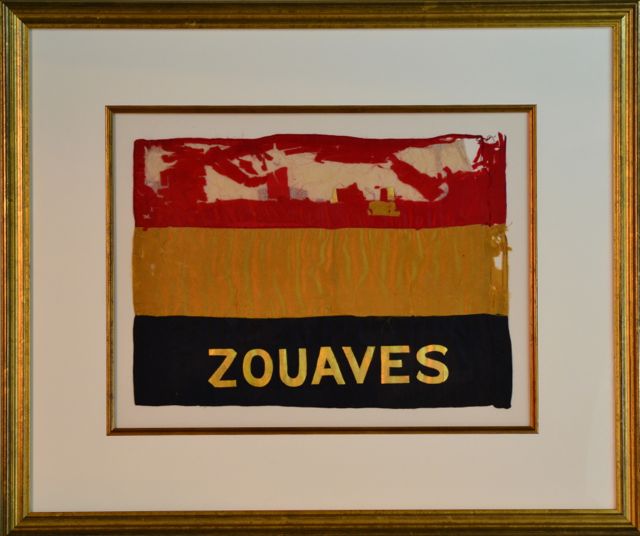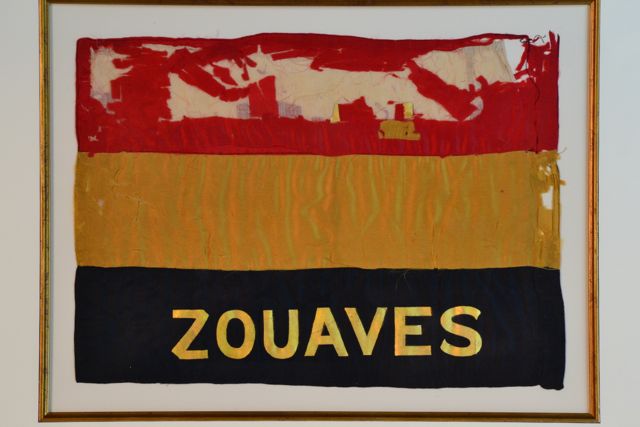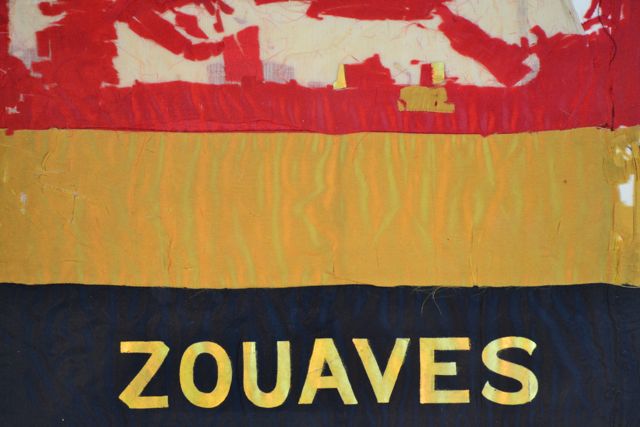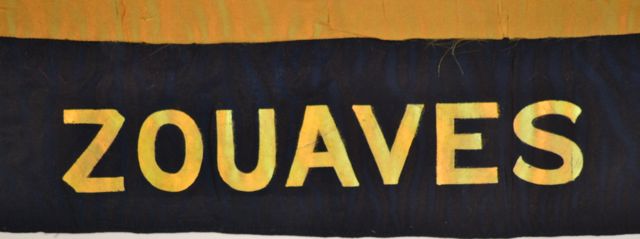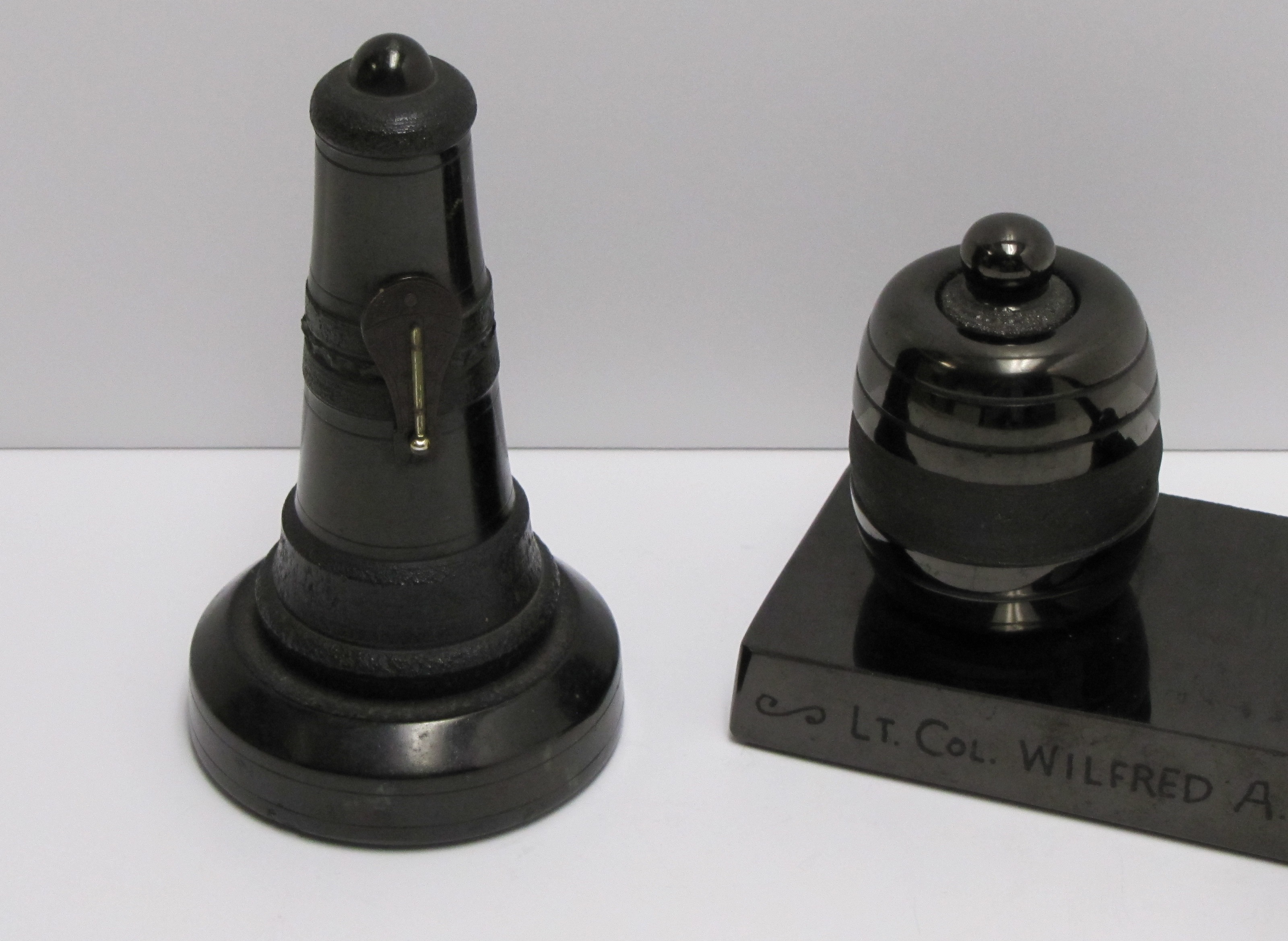Description
Rare antique Zouaves Re-union silk flag ~
Rare flag to add to your Civil War Collection
Banner. Made of heavy silk with single line treadle stitching. Hand painted letters with gold paint. Conserved at one time in the past as it is mounted to a linen backing. As is condition. ZOUAVES in The Civil War Numerous Zouave regiments were organized from soldiers of the United States of America who adopted the name and the North Africaninspired uniforms during the American Civil War.[17] in 1861 The Union army had more than 70 volunteer Zouave regiments throughout the conflict, while the Confederates fielded about 25 Zouave companies.[18 American Zouave uniforms The zouave uniform was sometimes quite elaborate, to the extent of being unwieldy. Some Zouave regiments wore a fez with a colored tassel (usually yellow, blue, green, or red) and turban, a tight fitting short jacket (some without buttons), a wide 10-foot-long (3.0 m) sash, baggy pantaloons or “chasseur” trousers, white leggings, and a short leather cuff for the calf, called jambieres. The sash was especially difficult to put on, often requiring the help of another zouave. The zouave uniform was better suited for warm climates and rough terrain. The loose pantaloons allowed for greater freedom of movement than trousers, while the short jacket was much cooler than the long wool blouse worn by most armies of the time. One of the reasons for the smaller number of zou ave units in the U.S. and Europe was the expense of the specialised uniform over that of mass-produced uniforms of a single color and cut. Post Civil War Zouaves gradually vanished from the U.S. military in the 1870s and 1880s, as the militia system slowly transformed into the National Guard. As an example, the Wisconsin militia still included one zouave unit in 1879 but the following year a standard Wisconsin Guard uniform was adopted and the traditional distinctions of title and dress ceased. After the Civil War, veteran groups sometimes dressed as zouaves during honor guard ceremonies such as funeral processions, since zouave dress was considered colorful and distinctive. Modern American Civil War reenactments often feature Zouave units. Silk starts to split and crack when its around 100 years old. Based on the wear and condition of this rare piece of Civil War memorabilia it appears to be circa 1880 to 1900
Historical Americana has been buying and selling antique American Flags and Americana for over twenty years. I have personally seen and handled and purchased thousands of antique flags over the years.
I have consulted with numerous museums across the country including The National Archives, PBS, various film production companies for national TV Shows, major motion pictures, major collectors, and large and small auction houses over the years in selling, loaning, describing, documenting, and identifying various antique flags and antique textiles.
I have been interviewed for many national magazines and newspaper articles on antique flags and rare Americana.
Our flags and rare Americana have been featured in numerous antique trade publications, newspapers and major national decorator magazines, national TV shows and major movies.
I have also worked with numerous major retail corporations, major on-line retailers, major on-line catalogs, many prominent national interior designers, and architects.
Historical Americana has been buying and selling rare, unique antique relics and rare American Flags and Americana for over twenty years. I have personally seen and handled and purchased thousands of antiques & antique flags over the years.
We use modern museum framing technology to frame our antique flags.
Please do not be intimated by dealers that have outrageous prices on their flags and say if any flags is sold for less than their (highly inflated prices) it can’t possibly be real. Really?…
If you want to pay more for the same flag, please do
I have more experience on antique flags than most museum curators, auction house appraisers who may see only a few flags each year and most flag dealers sometime make erroneous statements and opinions on flags because of lack of experience.
Conservation
Our in-house professional framers use only conservation framing methods used by museums. We only use acid free cotton rag mats and gas free materials along with safe ultra-clear UV acrylic. The UV acrylic is clearer than glass and unlike glass it will not break. Our flags are museum mounted using safe acid free hinges, which does not damage the flag in any way like sewing flags down does. The hinge mounting is completely reversible which is the prime focus to achieve in conservation framing.
Sewing a flag down as some framers and company’s do is very costly to the customer and can damage the flag. Sewing flags down is an out of date, old process that can and usually does damage the flag over time as it hangs in the frame. In some cases, sewing the flag down can cause irreparable damage and ruin your investment in the flag you purchased.
This is what happened to the Old Glory Flag in the Smithsonian. The Smithsonian conservators spent millions of dollars to repair and reverse the damage to the flag caused by sewing the historical flag down. Framers have used the sewing method in the past and some do now because they do not know any better and are stuck with a failed technology and the main reason is they make much more money from the customer by charging huge fees to sew a flag down. Time has proved sewing a flag down is damaging to the flag and very costly to the customer. Our mounting process is safe, cost effective and preserves the antique flag for generations to come.
We do all this and sell our flags at very reasonable prices unlike many dealers…
Selling only Genuine Authentic antiques & rare American Flags
Email flaginfo2012@gmail or call to purchase.

